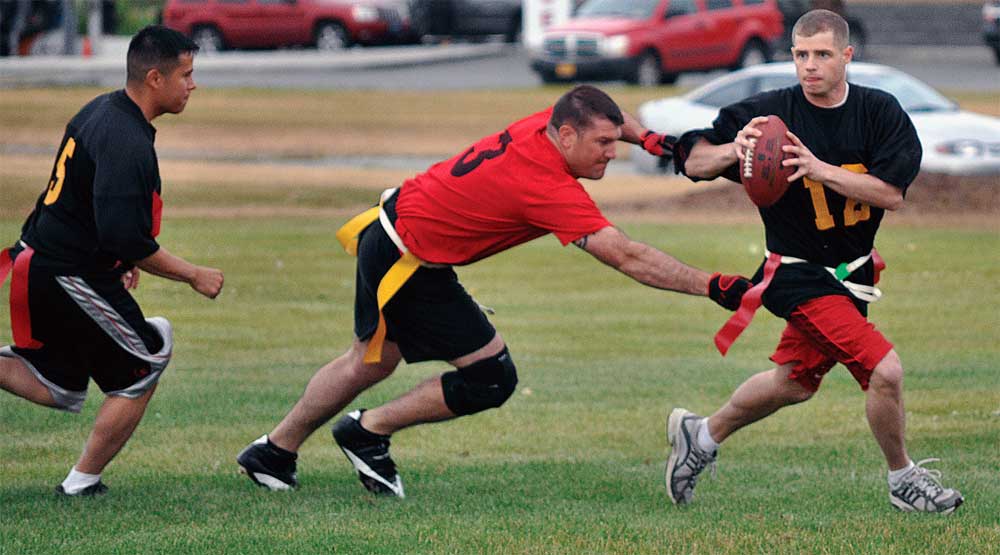
Over the past few years there has been a surge in flag football participation. Players are ditching helmets and shoulder pads for belts with flags.
Collegiate and professional players are starting to quit or retire in escalating numbers. High profile athletes are publicly supporting the push for flag football at the youth and teenage level.
Research and statistics have shown that chronic traumatic encephalopathy (CTE) is a major threat to athletes playing tackle football. It’s easy to assume that flag football leagues and participation will continue to rise since CTE has been directly linked to dementia, chronic depression, suicide, vision impairment, and long-term memory loss.
Research on CTE from the National Football League has had a trickle-down effect for participant safety. Jason Breslow’s 2014 article “76 of 79 Deceased NFL Players Found to Have Brain Disease” mentions how doctors studied the brain tissue of 128 football players and found that almost 80% had CTE.
In the fall of 2015, Boston University and the Department of Veterans Affairs found that 87 of 91 former NFL athletes tested positive for CTE. Further research factored semi-pro, high school and collegiate players into the mix and found that 79% had CTE. This research data, coupled with former players speaking out about their concussion experiences, has served as the catalyst behind the growth in flag football.
Parents are making their stance clear. They don’t want their child taking the blows that come with tackle football. The marketing pitch for flag football is safety – primarily concussion prevention. Flag football advocates do have a valid argument. For example, let’s say that we have a sixth grader who is playing tackle football and his position is on the offensive line – a position that requires physical contact almost every play. With individual periods, one-on-one drills, half-line segments, scrimmages, and games, it wouldn’t be uncommon for your child to make physical contact 40 times each practice segment. Let’s take a look at the numbers of hits that could potentially occur in one season.
15 spring practices + 24 in-season practices + 8 games x 40 hits per outing = 1,880 hits
That’s nearly 2,000 times in one season a player is either delivering a hit or absorbing one. If you assumed this number for all three years of middle school then the total rises to 5,640. As a parent, having your child play flag instead of tackle through middle school could save them from 5,640 potential hits. Looking at numbers long-term, imagine how many hits a player will take when playing four years of high school football…possibly four-to-five years of college…maybe some professional football. The number of hits and risks continue to rise the longer an athlete plays.
It would be naive to think that all of those hits over that span of time wouldn’t take a toll on the body and mind. These hits are even more damaging during the prime years in which brain and physical development is occurring.
The safety argument is valid for flag football but players are still at risk. Some flag football injuries include dislocated elbows and hips, torn knee ligaments, broken noses, fractured collarbones, broken fingers, eye injuries, and various foot injuries. This isn’t surprising. When you accelerate full speed at someone in tackle football you can “run through them” or collide with your protective gear on. In flag football, there is no protective gear to stop any type of physical contact or hard collision that may occur, as players are usually wearing a t-shirt or loose fitting jersey and shorts. The risk for concussion is minimal in flag, but there are still plenty of ways to become injured.
Regardless of which type of football is played, the athlete has to be ready to face injury every time they lace up. It is important for parents and coaches to speak with children about safety concerns, evaluate the pros-cons, and then decide on the safe(r) option.
By Zac Tubbs, M.S.
Zac Tubbs is a former professional athlete who has spent time as a sport marketing instructor, collegiate coach, and professional scout. He holds a master’s degree in sport and fitness management and a bachelor’s degree in career and technical education. He also earned a Collegiate Compliance certificate in 2011 from the United States Sports Academy.